Estimating the Potential Profit Gains from Lowering Employee Health Care Costs for America’s Largest Companies

Table of Contents
Author(s)
Alan Beltran Lara
2021-2022 EMERGE Intern, Center for Health and BiosciencesCindy Nguyen
2022 EMERGE Intern, Center for Health and BiosciencesMarah Short
Scholar in Health EconomicsVivian Ho
James A. Baker III Institute Chair in Health EconomicsShare this Publication
- Print This Publication
- Cite This Publication Copy Citation
Alan Beltran Lara, Cindy Nguyen, Marah Short, and Vivian Ho, "Estimating the Potential Profit Gains from Lowering Employee Health Care Costs for America’s Largest Companies" (Houston: Rice University’s Baker Institute for Public Policy, September 19, 2022), https://doi.org/10.25613/X90V-PN60.
Abstract
Employers’ health insurance premiums have been rising faster than both wages and inflation for decades. Therefore, one of the highest priorities for employers should be addressing the affordability of health care. We combine data from multiple sources to estimate the potential profit gains for the 2021 Fortune 500 companies from lowering overall employer-sponsored insurance (ESI) costs by the same amount achieved by 44 of the most successful companies that have already done so, as identified by Willis Towers Watson. We estimate the median potential gain in profits from lowering ESI spending by $1,373 per employee per year is 3.54% for Fortune 500 companies. We find that these benefits vary greatly both within and between industries. Labor-intensive industries stand to see the largest profit gains from reducing their health care costs, although capital-intensive industries currently spend the largest percentage of total compensation on ESI. Thus, employers’ gains from lowering ESI costs depend on both the ratio of capital to labor, as well as the skill level of labor required to successfully do business. Given the returns at stake, CEOs and shareholders should pay increased attention to obtaining affordable, high-quality health insurance coverage for their workers.
Background
In 2020, the Kaiser Family Foundation (KFF) found that employers are the largest single source of health insurance coverage in the United States, covering 50.3% of the population or approximately 163 million individuals.[1] Thus, any factors that alter the affordability of employer-sponsored insurance (ESI) can have significant consequences for the many workers who depend on it. With this unique position of control over employees’ plans and negotiating power with insurance companies, employers could be growing their businesses by identifying opportunities to reign in the costs of health insurance coverage while maintaining or improving the quality of these benefits. This research aims to investigate the possibility of maintaining good ESI coverage while decreasing overall spending by employees and employers.
Many studies, like Mercer’s “Health & Benefit Strategies for 2023 Report,”[2] identify trends in ESI offerings and employee preferences, especially in light of the COVID-19 pandemic, but few directly investigate potential factors to reduce overall spending. Others, like Willis Towers Watson, identify possible sources of improvements to cost efficiency. Their “2019 Best Practices in Health Care Employer Survey Report” saw an average savings of $1373 per employee per year for the “best-performing” companies with comprehensive health coverage.[3] Recognizing that high quality coverage is essential to employee satisfaction, Willis Towers Watson accounted for plan generosity when identifying the best-performing companies. We used this report and other sources of data such as the Bureau of Labor Statistics (BLS) to estimate how a reduction in ESI spending could increase profits for the 2021 Fortune 500 companies. Our estimates offer insight into how addressing health care costs could influence the overall financial performance of America’s largest firms.
The role that health care costs have played in employers’ bottom lines and workers’ paychecks has increased over time. Data from the annual KFF “Employer Health Benefits Survey”[4] shows that overall, insurance premium costs are rising even after adjusting for inflation (Figure 1). At the same time, the share of premiums paid by workers has effectively remained constant (Figure 2), putting downward pressure on workers’ take-home pay. Furthermore, the BLS “Employer Cost of Employee Compensation” (ECEC) report shows that overall employer spending on wages and salaries has risen only 18% since 1990, while employer spending on health insurance has risen 47% (Table 1). On top of a global pandemic that has amplified the need for comprehensive health benefits, workers have faced rising premium costs with few new resources to pay them, as wages have only marginally increased. Thus, there is a need to understand which types of firms, industries, and employers could benefit the most from reduced ESI spending while keeping employees covered.
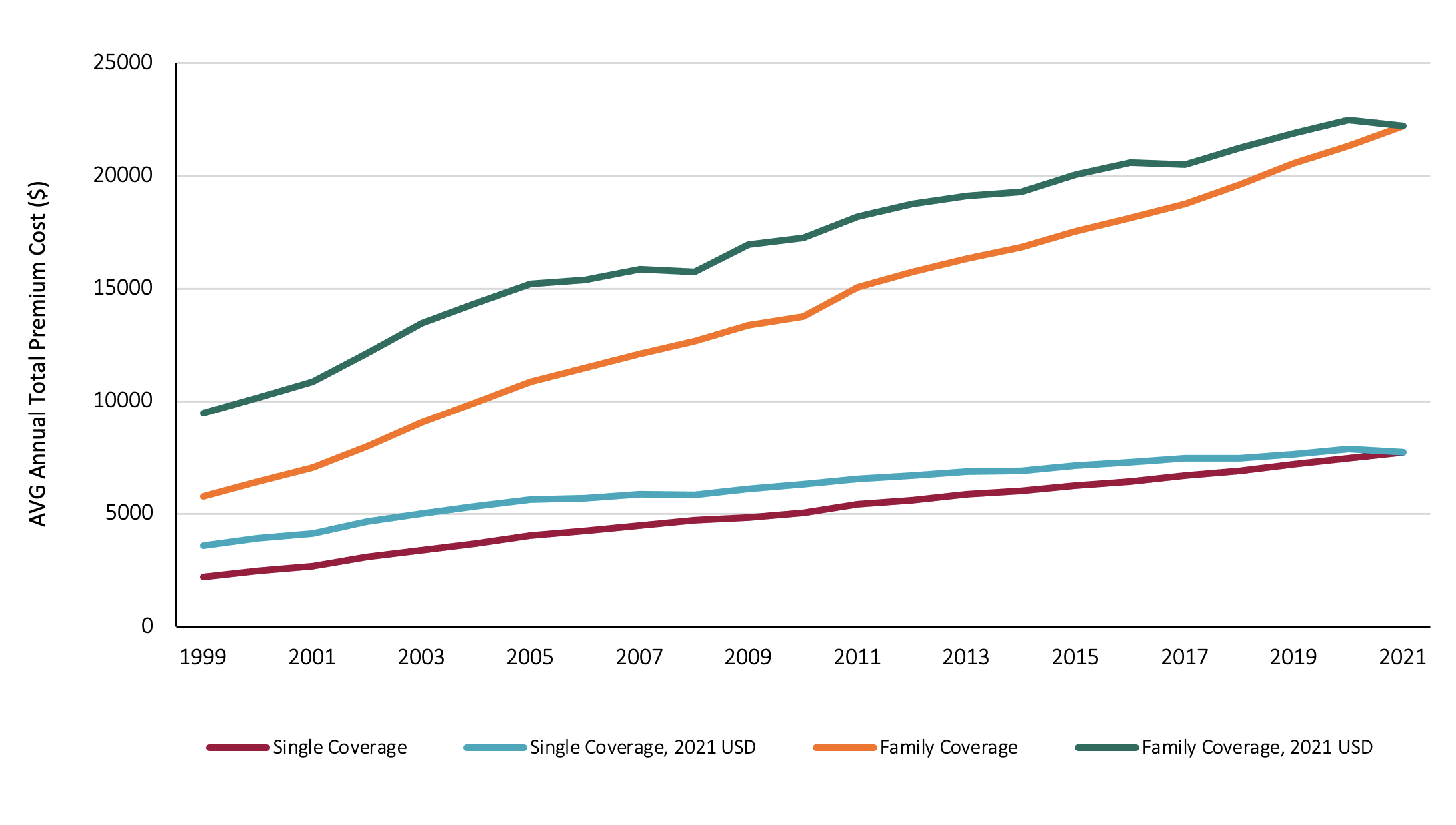
Sources KFF[5] and author’s calculations using BLS CPI data.[6]
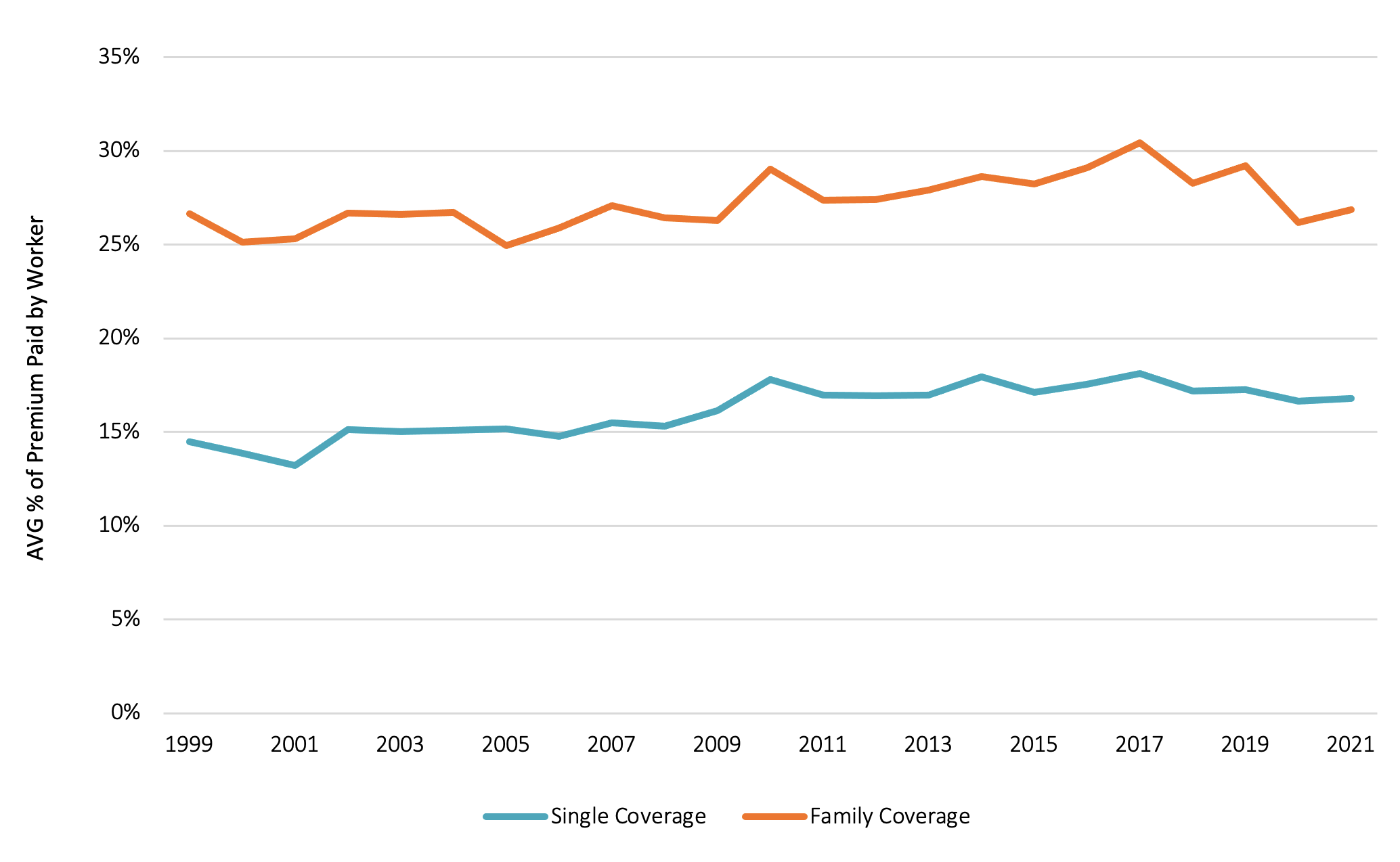
Source KFF.[7]
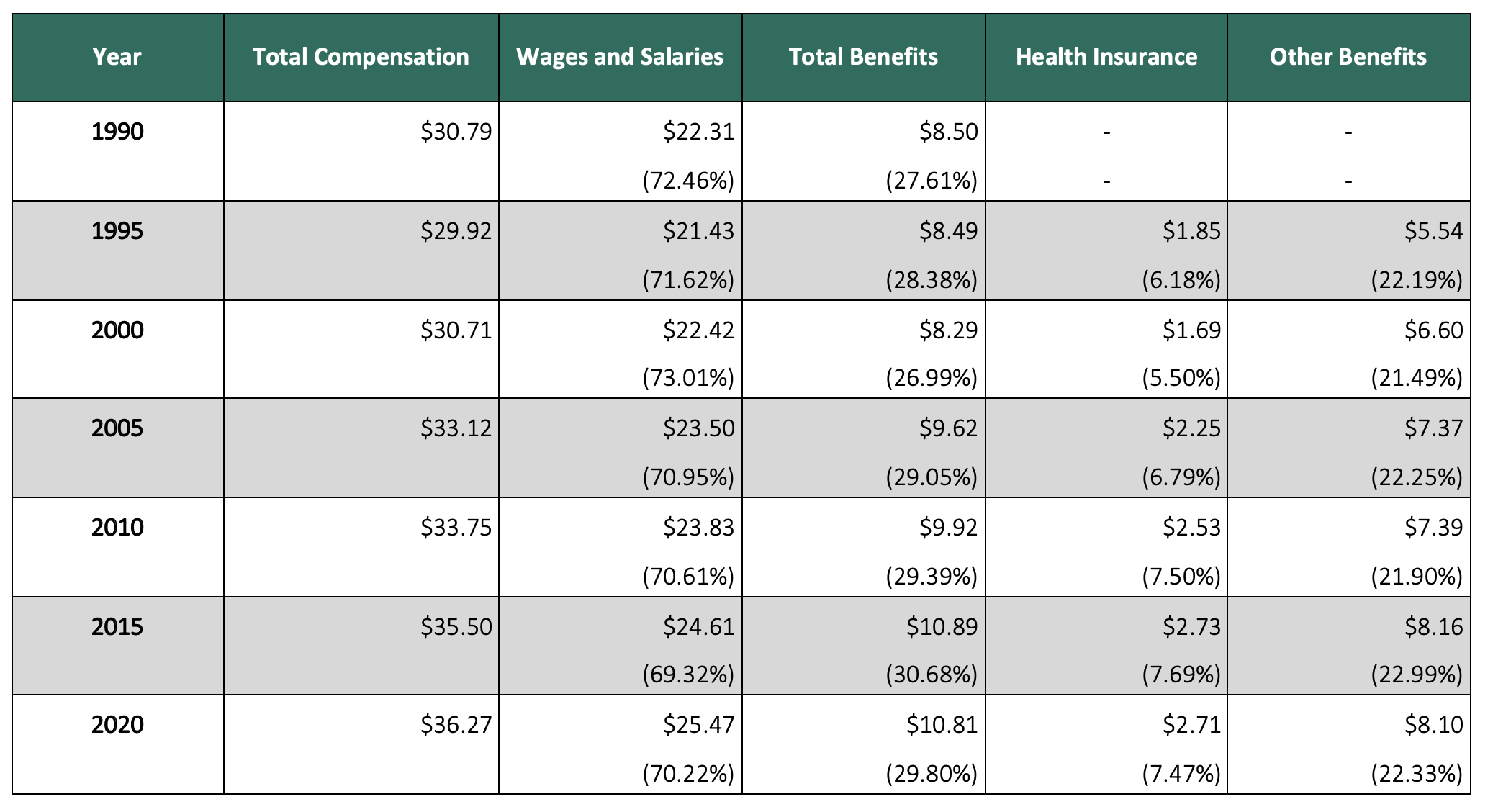
Source Bureau of Labor Statistics[8]
Methods
We started by collecting data on companies, including their rankings, revenues, profits, and number of employees from the 2021 Fortune 500 list.[9] This collection and organization occurred during May and June of 2022.
Our goal was to calculate the financial benefits a company would see from reduced health benefits costs while maintaining adequate comprehensive coverage. However, since we did not have data on the specific employer costs of insurance for each individual Fortune 500 company, we looked for an estimate that could be applied to all companies based on reasonable assumptions. We conducted a literature search for studies concerning best practices in ESI programs and determined that data from a 2019 Willis Towers Watson “Best Practices in Health Care Employer Survey Report” represented the best estimate of benefits from increased efficiency, careful attention to plans, and other practices. They estimated best-performing companies would pay $1,373 per employee per year (PEPY) less in ESI costs than the national average of $11,887.
Though the report lists this number in 2019 dollars, we used consumer price index (CPI) data from the BLS to convert it into 2021 dollars based on the rise in consumer prices for medical care. We then multiplied this inflation-adjusted PEPY figure by the number of employees in each Fortune 500 company to estimate how much less each company might pay for ESI if it implemented these best practices. Recognizing that the amount of attention an employer might wish to direct toward health care costs depends on the relative impact these costs have on overall financial performance, we expressed this “savings” amount as a percentage of the increased 2021 profit each company might have seen. Absolute numbers were used in the case of negative profits. The Willis Towers Watson survey designated 44 companies as best performers, but we do not know their identities. Some of these companies were likely Fortune 500 firms. For this group of companies, we are overestimating the potential gains in profits from reducing their health care benefits costs. However, we have no reason to believe these firms are concentrated in particular industries. Therefore, the overestimation is not likely to be substantial for our overall calculations or estimates by industry.
While each company belongs to an industry group categorized by Fortune magazine, we opted to use the more standardized North American Industry Classification System (NAICS) used by the federal government. Using information found on Mergent Online, a comprehensive global company database, we assigned the proper NAICS industry and code to each Fortune 500 company and grouped industries by the leading two-digit NAICS sector code. The manufacturing sector was further divided into two components, durable and nondurable goods manufacturing. Using this classification resulted in 16 industry groups. Although similar companies were sometimes placed across a variety of groups, the groups remained true to the companies’ primary activities. For example, while Apple and Amazon are both technology companies, Apple is classified as a durable manufacturing company that makes computers and electronic products while Amazon is considered a professional, scientific, and technical services company. Likewise, notable energy companies may have been classified under either utilities or mining.
We hypothesized that the potential savings from reducing employers’ health care costs may vary according to the relative importance of capital versus labor in a company’s business. BLS data from the Office of Productivity and Technology was used to measure labor and capital for each industry group. Labor was represented by the total hours worked in the entire year. Capital was represented by the value of all assets of productive capital stock in the same year. Both measures were taken from the most recent available year, 2019. Data from the consumer price index for all urban consumers (CPI-U) was used to convert capital values to 2021 dollars. We then calculated a capital/labor value (K/L) that indicated whether an industry group tends to be more capital or labor oriented.
Data on current national and industry ESI employer spending came from the BLS ECEC reports, where we found employee compensation data that includes health insurance and other benefits by industry groups and worker types. The cost of employee compensation is measured in dollars per hour of labor worked and as a percentage of total compensation. The presented industry groups are largely the same NAICS industry groups defined above with three main exceptions: 1) the agriculture, forestry, fishery, and hunting industry group is not included; 2) the mining industry group is not directly reported but rather estimated based on a weighted average of the construction and manufacturing groups in their respective good-producing categories; and 3) the manufacturing group is not divided into durable and nondurable goods. We focused our analysis on civilian private industry workers since the Fortune 500 does not include companies in the government sector.
To better understand patterns behind health insurance premiums over time, we looked at data from the KFF “2021 Employer Health Benefits Survey.” This survey breaks down premiums, deductibles, ESI availability, and more by a variety of factors. However, we primarily focused on data available for total premiums as well as worker and employee contributions for all firms and plans from the earliest available year (1999) to the latest (2021). Premium costs were analyzed at face value, as well as inflation-adjusted values using the BLS CPI inflation calculator, and as contribution percentages of the total cost.
Results were summarized using descriptive statistics, including percentages, medians, and ranges for each industry group. Medians and ranges for industry group profit increases, labor, capital, and K/L were graphed in order to find patterns or correlations between variables. When values were not available on an industry-wide scale, such as for-profit effects, we calculated the industry group median value based on all companies within that group. Though our analyses of industry group profit effects focused on median values, we also graphed weighted averages based on the number of employees of each company to get a better sense of distribution. We were primarily interested in any correlations between the percent profit increases for industry groups and K/L, as this would give us insight into how reliance on capital versus labor affects the magnitude of reduced ESI spending. We also measured the correlation between K/L and current employer spending on insurance from the December 2020 ECEC report to gauge which industry groups are already heavy spenders and which companies’ employees are more likely to be affected by cuts to spending. Because of how much data varied and led to nonlinear patterns, we ranked each industry group in our list based on the relevant measures and graphed these ranks to find correlations.
Results
There was a wide distribution of Fortune 500 companies in each industry group, with the largest group (finance and insurance) having 95 companies and the smallest group (agriculture, forestry, fishery, and hunting) only three companies (Table 2). Industry group names have either the top two-digit NAICS classification(s) or sub-group initials appended.
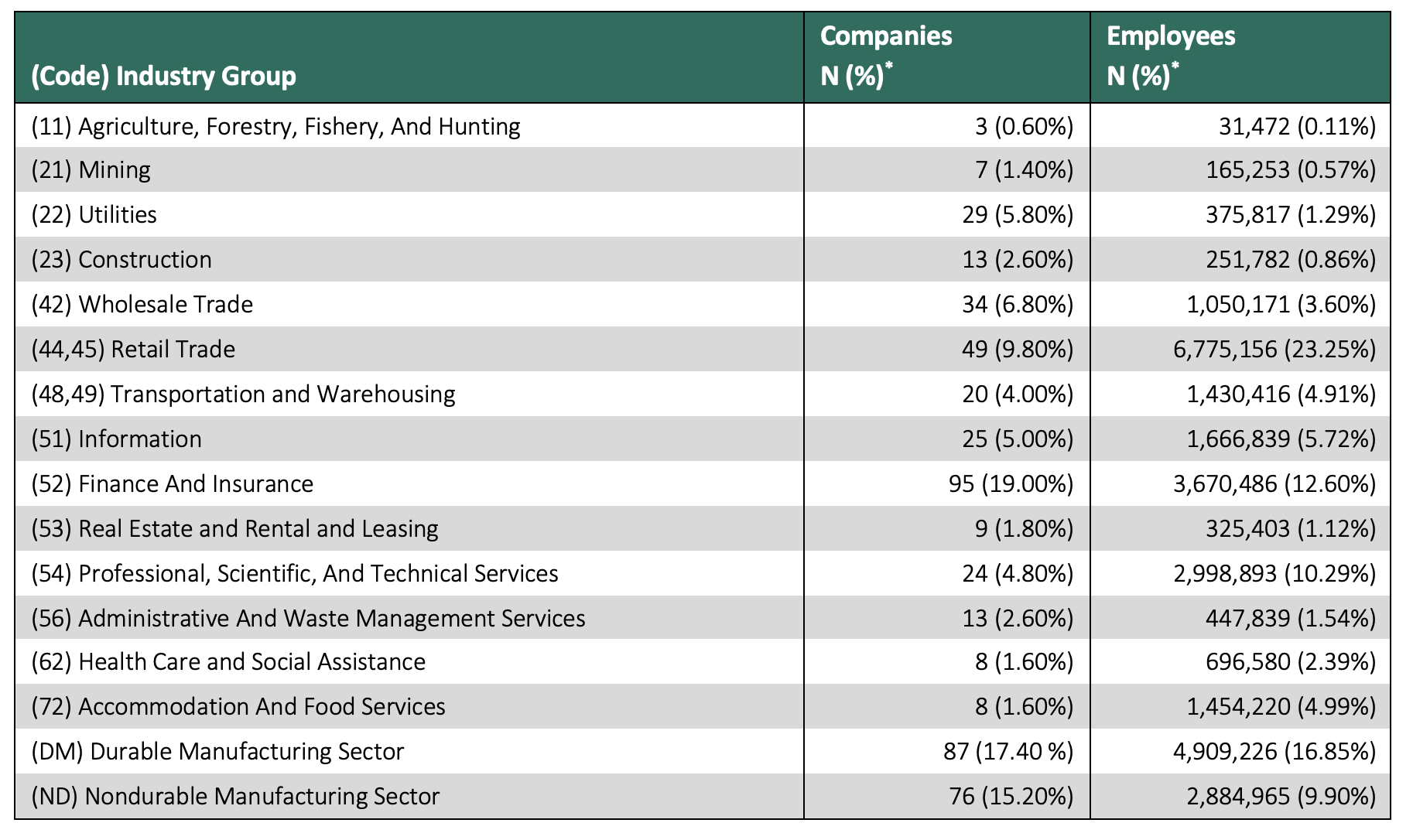
* Percent as a proportion of all Fortune 500 companies.
Sources Fortune 500, Mergent Online, Bureau of Labor Statistics.
Applying our inflation-adjusted figure from Willis Tower Watson to all Fortune 500 firms, the median potential gain in profits from lowering ESI spending by $1,373 PEPY was 3.54%. The estimated mean potential gain in profits weighted by the number of employees in each firm was 31.77% (excluding one significant outlier, the firm ABM Industries). We found a highly skewed range of potential percent profit increases from reduced ESI spending by industry (see Figure 3), which explains the large difference between the median and weighted mean statistics. All industries, except mining, have estimated potential profit gains greater than 1%. Three groups have median potential gains above 10%, the largest of which belongs to the accommodation and food services group at almost 52%. Almost all weighted averages are larger than the median values due to the fact that profit gains are calculated using employee numbers, which means more employees lead to larger values. Furthermore, firms and industries with very high profit gains also typically have low profits, which, due to the nature of the calculations, results in very high numbers. For example, ABM Industries sees a remarkably high 54,264% estimated profit gain, because they have over 100,000 employees and saw a profit of only $0.30 million USD. Company-level profit gains are available in the appendix.[10]
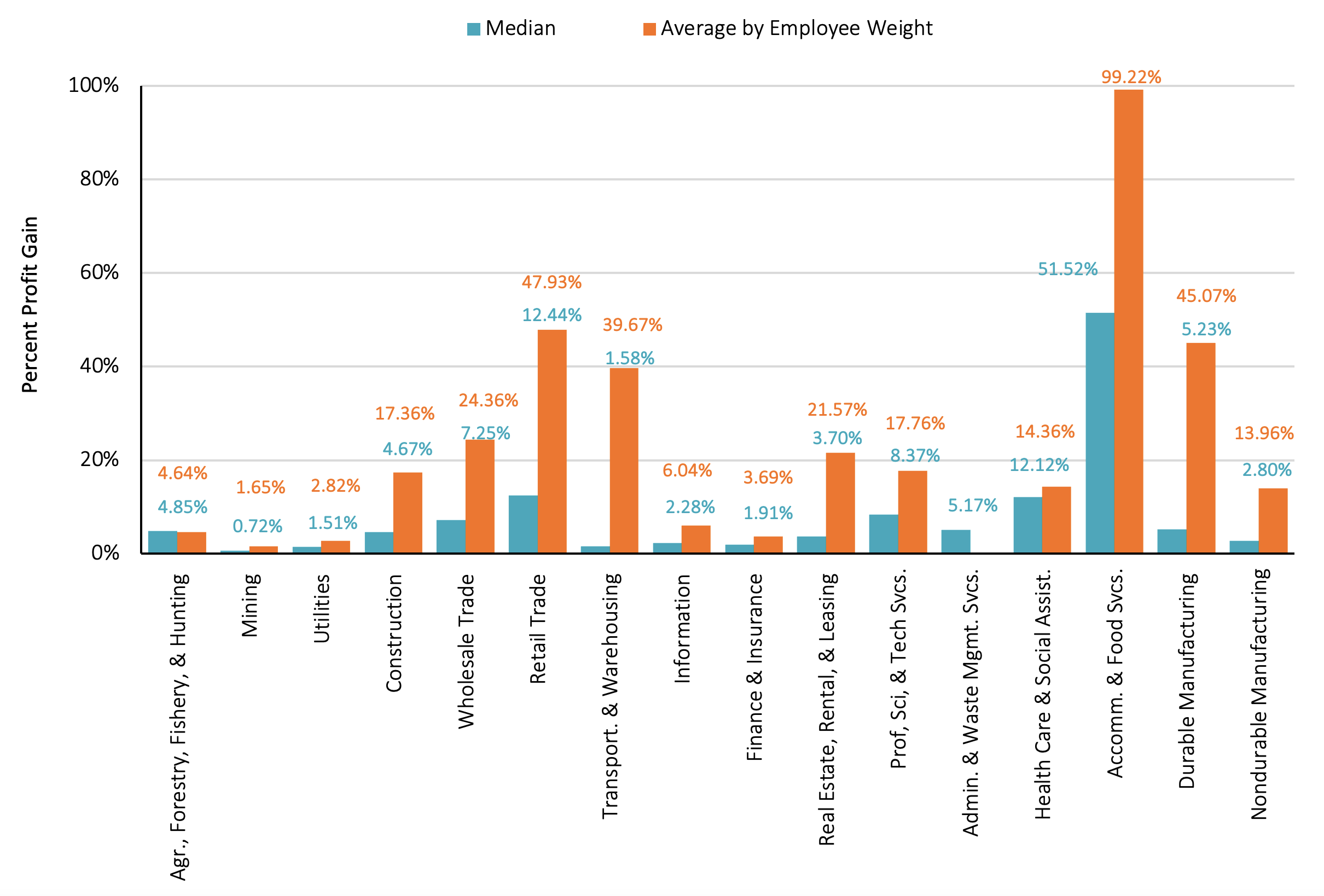
* Weighted average for the administrative and waste management services group (13833.95%) is excluded to make the scale clearer to see.
Sources Fortune 500, Willis Tower Watson, author calculations.
We observed a correlation between an industry group’s median potential percentage profit increase and its reliance on capital relative to labor. Among the 16 industry groups represented by Fortune 500 companies, those with a relatively higher K/L ratio also tended to have relatively lower potential percentage profit gains from reducing health care premium costs. Figure 4 plots this relationship according to each industry group’s ranking in our dataset for both K/L and median percent potential profit gains. Lower rank values on the vertical axis represent higher ratios of capital to labor.
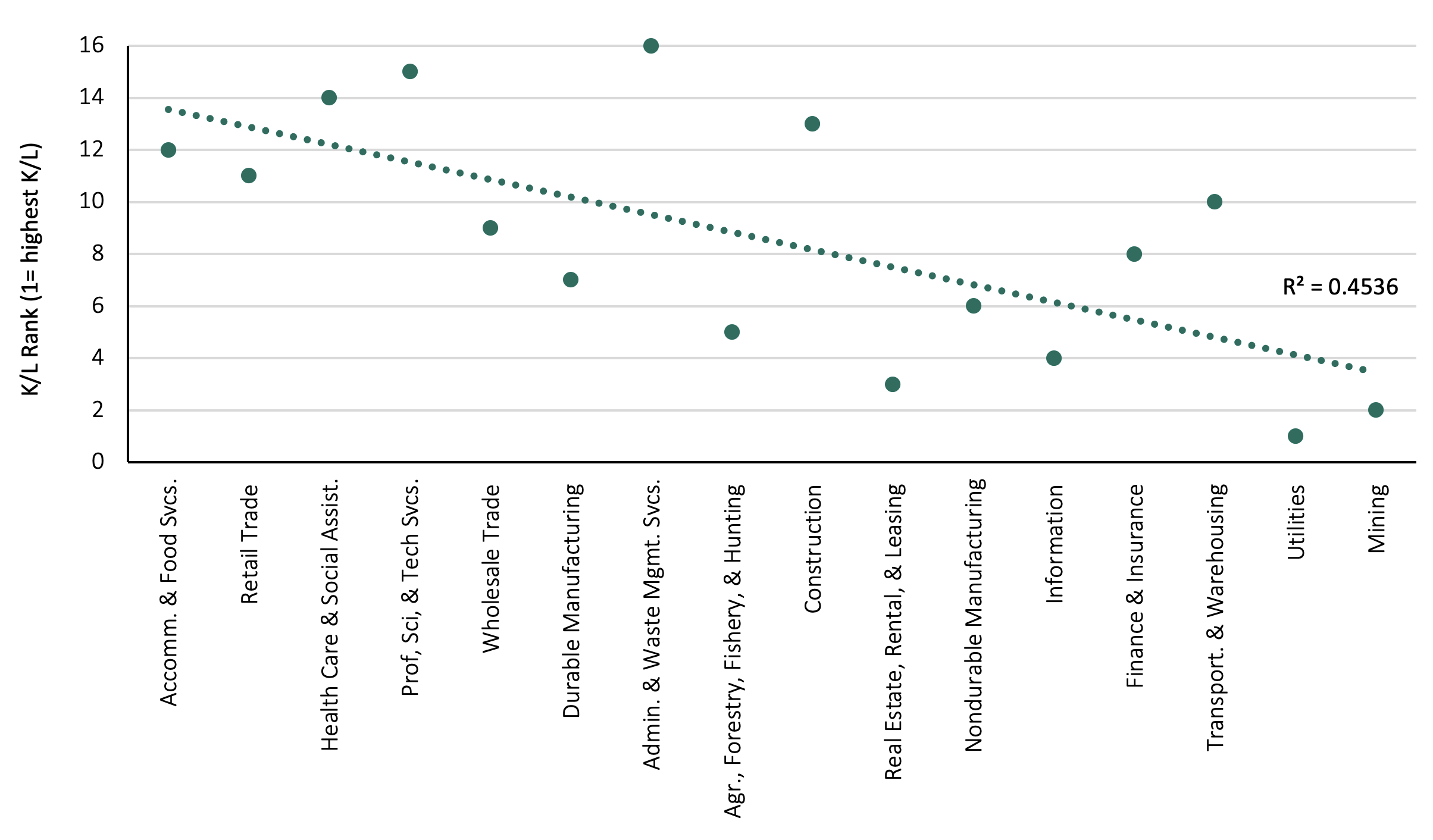
Note Industries ranked by median potential percent profit gain, high to low.
Sources Fortune 500, Willis Tower Watson, author calculations.
Furthermore, there is a correlation between an industry group’s K/L and its spending on insurance for employee compensation. After adjusting our labor and capital measures to match the shortened list of industry groups included in BLS ECEC data, we observed that industries with a higher relative K/L also tend to spend more on insurance as a percentage of all compensation. This is visible in Figure 5, which graphs relative ranks of both K/L and insurance share of labor compensation in 2020 for available industry groups. In short, this shows that capital-intensive industries presently spend more of their share of employee compensation on insurance than labor-intensive industries do.
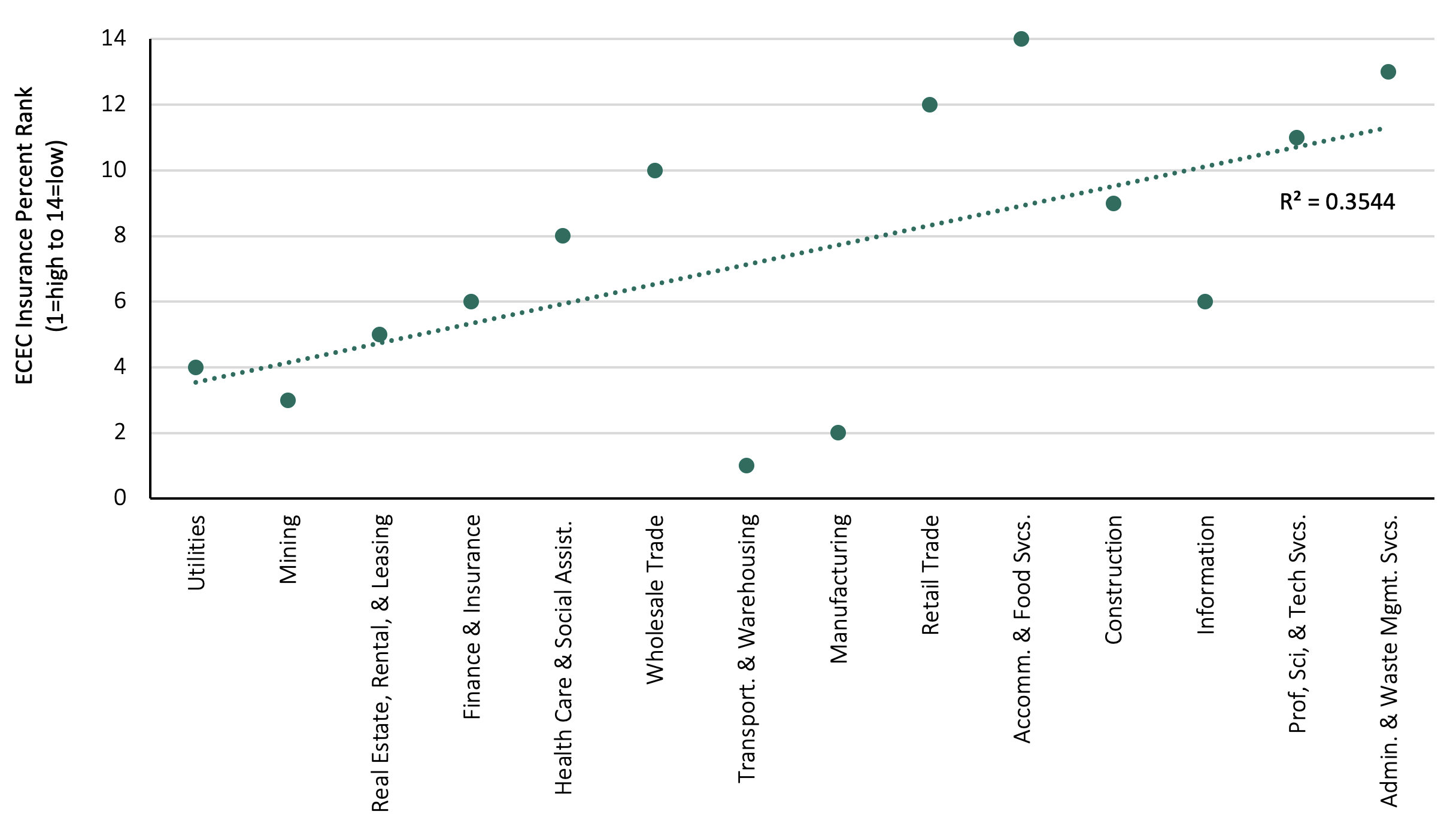
Note Industries ranked by median potential percent profit gain, high to low.
Sources Fortune 500, Willis Tower Watson, author calculations.
Discussion
Employers’ health insurance premiums have been rising faster than both wages and inflation for decades. Therefore, one of the highest priorities for employers should be addressing the affordability of health care.[11] Our general findings about the benefits of ESI spending cuts highlight the link between increased affordability and increased profit. The “2019 Willis Tower Watson Best Practices Survey Report” goes into more detail about the nature of these best practices, which include such things as increased efficiency from onsite care offerings.
We find that while all industries stand to benefit from lowering ESI costs to some extent, there are differences among them. Industries that are more labor intensive rather than capital intensive may see the largest benefit to their profits from decreased ESI spending.
The substantial differences between the median and weighted average potential profit gains from reducing ESI costs in some industries suggest that potential benefits also differ widely within industries. For example, based on our calculations, without taking into account individual firms’ benefit packages, one firm in the accommodation and food services industry group sees a potential profit gain of over 50%, while another only sees an increase of about 6%.[12] This difference is due to the latter’s much higher profit, although both nominal values are nevertheless in the hundreds of millions. Furthermore, since we use data from the 2021 Fortune 500 list, employee numbers and profits (prior to spending cuts) may have been affected by the COVID-19 pandemic. Thus, future research should be done over multiple years to see if the patterns described here have changed over time or hold constant before and after the pandemic.
It should not be surprising that capital-intensive industries are more likely to face lower potential profit gains. Though there are probably a variety of factors at play, we suspect this relationship exists because capital-intensive industries prioritize efficiency in labor compensation at a lower rate than labor-intensive industries. High equipment and other capital stock costs may simply overshadow labor compensation costs, making the benefits of decreased spending in ESI, and thus labor compensation, appear low. Labor-intensive industries may also include employees from many different backgrounds, which only exacerbates this discrepancy. The accommodation and food services industry group, for example, sees the highest median potential profit increase, but companies within this group oftentimes cycle through many employees who vary based on age, economic circumstances, and number of dependents.[13] Nevertheless, solutions proposed in the Willis Towers Watson report, such as on-site care and value-based plan designs,[14] seem promising as strategies to lower health care costs in this population.
Discussion of capital-intensive versus labor-intensive industries, however, should also keep in mind what Figure 5 seems to imply: Capital-intensive companies already spend proportionally more of their total compensation on health insurance. For example, mining, which contains many prominent energy companies like ExxonMobil, has the second-highest K/L value and the third-highest percentage of employee compensation costs spent on insurance. Our measure of labor is the number of hours worked in the industry, which doesn’t account for differences in salaries across industries. Capital-intensive industries may have higher proportions of high-skill, high-wage workers, who may expect better insurance and other benefits.
Research suggests that much of the increase in health insurance premiums over the past two decades is attributable to increased consolidation of health care systems.[15] Health insurers that negotiate on behalf of employers may have experienced reduced bargaining power as providers consolidated—particularly if employers who were eager to retain highly skilled workers exhibited inelastic demand for worker coverage. The five industries with the lowest potential profit gains from cutting ESI spending comprise 25.09% of employment in the Fortune 500 companies. This relatively large share of workers with less to gain from cutting ESI spending may have aided providers’ ability to raise prices. For this reason, some employers are moving beyond just the best practices for controlling ESI spending, as mentioned by Willis Towers Watson, and forming employer purchasing coalitions[16] and engaging in direct contracting.[17] Health insurance premiums may not be the greatest barrier to high profits for many large companies, but a significant number of Fortune 500 firms have much to gain from lowering ESI spending—and they will need to act creatively and forcefully to improve their financial soundness and that of their workers.
Endnotes
[1] “Health Insurance Coverage of the Total Population (CPS),” KFF, accessed July 28, 2022, https://bit.ly/3BbQGRm.
[2] “Health & Benefit Strategies for 2023,” Mercer, accessed July 28, 2022, https://www.mercer.us/our-thinking/healthcare/2023-benefit-strategies-report.html.
[3] “Best Practices in Health Care Employer Survey Report,” Willis Tower Watson, April 3, 2020, https://www.wtwco.com/en-US/Insights/2020/03/2019-best-practices-in-health-care-employer-survey-report.
[4] “2021 Employer Health Benefits Survey,” KFF, November 10, 2021, 39, https://www.kff.org/health-costs/report/2021-employer-health-benefits-survey/.
[5] Ibid, 39.
[6] “CPI Inflation Calculator,” BLS, accessed July 28, 2022, https://www.bls.gov/data/inflation_calculator.htm.
[7] “2021 Employer Health Benefits Survey,” 75.
[8] “Employer Costs for Employee Compensation Archived News Releases,” BLS, accessed July 28, 2022, https://www.bls.gov/bls/news-release/ecec.htm#2020.
[9] “Fortune 500,” Fortune, accessed July 28, 2022, https://fortune.com/fortune500/2021/search/.
[10] Appendix.
[11] “2021 Employer Health Benefits Survey.”
[12] Appendix.
[13] Shannon Finn Connell, “The Opportunity for Diversity in the Food Service is at the Top,” Forbes, February 14, 2022, https://www.forbes.com/sites/forbescoachescouncil/2022/02/14/the-opportunity-for-diversity-in-food-service-is-at-the-top/?sh=3cb213815d8d.
[14] “Best Practices in Health Care Employer Survey,” 18.
[15] David Dranove, Big Med: Megaproviders and the High Cost of Health Care in America (Chicago: University of Chicago Press, 2021).
[16] “National and Regional Employer Groups Partner in Colorado to Jointly Contract with High-Quality Health Care Providers, Centers of Excellence,” Purchaser Business Group on Health, news release, June 18, 2021, https://www.pbgh.org/national-and-regional-employer-groups-partner-in-colorado-to-jointly-contract-with-high-quality-health-care-providers-centers-of-excellence/.
[17] Jonathan R. Slotkin, Olivia A. Ross, M. Ruth Coleman, and Jaewon Ryu, “Why GE, Boeing, Lowe’s, and Walmart are Directly Buying Health Care for Employees,” Harvard Business Review, June 8, 2017, https://hbr.org/2017/06/why-ge-boeing-lowes-and-walmart-are-directly-buying-health-care-for-employees.
Appendix
Click here to download and view the appendix materials.
This material may be quoted or reproduced without prior permission, provided appropriate credit is given to the author and Rice University’s Baker Institute for Public Policy. The views expressed herein are those of the individual author(s), and do not necessarily represent the views of Rice University’s Baker Institute for Public Policy.


